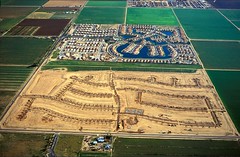More on suburban retrofit, from the NY Times

Posted January 12, 2009 at 10:35PM
Allison Arieff has a provocative post on her NYTimes.com blog ("What Will Save the Suburbs?"), questioning whether existing suburbs are beyond repair. She ponders the foreclosure crisis and the resulting abandonment of housing projects, and writes:
"In urban areas, there's rich precedent for the transformation or reuse of abandoned lots or buildings . . . But similar transformation within the carefully delineated form of a subdivision is not so simple. These insta-neighborhoods were not designed or built for flexibility or change.
"So what to do with the abandoned houses, the houses that were never completed or the land that was razed for building and now sits empty?"
She also wonders whether there is a re-use analogy similar to that being explored for abandoned big-box stores that could be applied to allow the re-use of badly designed developments. These are great questions to ask.
One answer, if they are truly the wrong developments in the wrong places with no people, is simply to let nature take its course. Better, though, are the many solutions offered by Ellen Dunham-Jones and June Williamson in their new book, Retrofitting Suburbia, published by Wiley and Sons. Some of the issues addressed include retrofitting garden apartments and residential subdivisions to address density and the new demographics, changing commercial strips to social and sustainable infrastructure (as we discussed here in the great success story of Rockville), converting regional malls to new downtowns by mixing uses and providing public space (as we discussed regarding Tysons Corner), and more.
Arieff's post is worth a peek just to riff through the comments, some of which offer some pretty funny suggestions. I didn't get in the game, unfortunately, until after a hundred of them had already been posted.
Image of development in Chandler, Arizona © 2008 Alex S. MacLean / Landslides. MacLean's stunning new book is Over: America at the Tipping Point.
